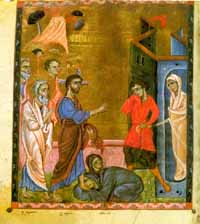|
Manuscript art is one of the most unique examples of Armeniaís
medieval culture. Due to her turbulent history many of the large
Armenian cultural monuments (monasteries, churches, palaces,
fortresses, etc.) were destroyed or plundered, and few other
examples have reached us in their original forms.
 But
manuscript art which was portable enough to be smuggled out
of harmís way, has left the world a legacy of some 30,000 known
Armenian manuscripts. How many more perished we can only imagine.
Within the margins of surviving manuscripts side notes describe
the loss of entire libraries of manuscripts at the hands of
Seljuks, Mongols and Turkish Ottomans as many as 10,000 at a
time. But
manuscript art which was portable enough to be smuggled out
of harmís way, has left the world a legacy of some 30,000 known
Armenian manuscripts. How many more perished we can only imagine.
Within the margins of surviving manuscripts side notes describe
the loss of entire libraries of manuscripts at the hands of
Seljuks, Mongols and Turkish Ottomans as many as 10,000 at a
time.
Large collections
of Armenian manuscripts are housed at libraries or museums in
Jerusalem, Venice (St. Lazaro Island), New Jhulfa, Moscow, Paris,
London and Los Angeles. The largest collection by far is that
housed at the Matenadaran (or Manuscriptorium) in Yerevan with
almost 17,000 manuscripts in total. Of that more than 13,600
are complete manuscripts, fragments of Armenian manuscripts,
Armenian talismans and new manuscripts.
Most of the history
of the Armenian people is concentrated in the Matenadaran, beginning
from the Hyksos invasion of Egypt in 1600 BC through the genocide
in 1915 to the modern era. Each one holds a small part of that
history. The oldest written memorials of the Armenian people
at the museum are parchment remnants from the 5th-6th
centuries, complete manuscripts from the 7th century,
and later, fossilized manuscripts and parchment fragments found
in caves. The oldest surviving complete Armenian manuscript
is a 7th century Gospel copied on parchment.
The manuscripts vary
in size and design, from a 5th century ivory bound
Gospel, the weighty Homilies of Mush, down to a minute
Calendar weighing 19 grams, which can only be read with a magnifying
glass. There are luxuriously bound editions of ecclesiastical
books, and there are plain looking but priceless editions of
songs, chronicles and philosophical treatises.
Another 2,800 manuscripts
are in Arabic, Farsi, Greek, Latin, Georgian, Hebrew, Assyrian,
Old Slavonic, Ethiopian, and other languages.
|



